Mallows are hardly the soft, spongy organisms the name suggests. If anything, they’re among the toughest and most versatile plants we can find in our natural areas or gardens this time of year. Most can grow in either sun or shade, and while they explode with blossoms after a good rain, they don’t demand water to survive.
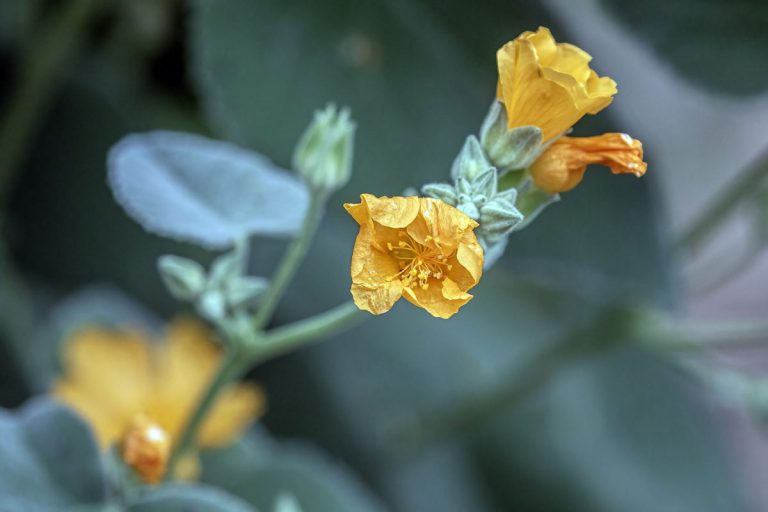
You want yellow? There’s a mallow that fits the bill. Want orange? There’s one of those, too. Pink? Red? White? There are mallows in all those hues.
A large and diverse family, mallows are characterized by showy flowers with five petals and simple, heart-shaped or rounded leaves. In many cases, stems are covered with tiny hairs and exude a slimy substance when crushed. Some mallows are annuals, but many are shrubby perennials, 2-6 feet in height. Prolific producers, mallows typically spread through self-seeding. The mallows most familiar to the typical gardener are altheas or Rose of Sharon, hollyhocks, and the many varieties of hibiscus, both exotic and endemic. Other well-known plants in the family are okra and coon.
Often less familiar, but of more interest to native plant gardeners in Central Texas are Turk’s cap (Malvaviscus arboreus), velvet-leaf mallow (Allowissadula holosericea), Indian mallow (Abution fruticosum), rock rose (Pavonia lasiopetala), winecups (Callirhoe leiocarpa), and spreading fanpetals (Sida abutifolia). A few of these can be purchased at native plant nurseries, and most can be found in San Marcos’ natural areas.
Turk’s Cap
Thirty-plus years ago, while shopping at a native plant nursery in Austin, I asked the owner if he had any Turk’s cap. His response was to laugh and tell me that if I really wanted Turk’s cap, he’d bring me a box full the following week—which he did. Turns out that the Turk’s cap at his place had gone crazy, spreading with gusto through his garden.
Fast forward several decades, that Turk’s cap he gave me has done the same. Wherever I put it, I now have a forest of Turk’s cap, some of it reaching 5 feet in height in a good year like this one.
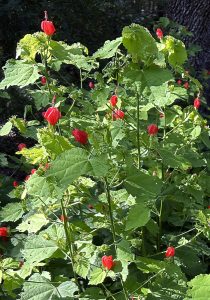
That’s not a bad thing, of course. I have the space for it, and it rewards me with an explosion of red each year. Turk’s cap is a favorite of hummingbirds, but it also attracts butterflies, moths, and other pollinators. Birds and small mammals enjoy the fruit as well.
One of the few natives that blooms prolifically in the shade, Turk’s cap can easily be propagated by root division—as I learned myself—or by seed. Look for it in the natural areas from late spring through fall.
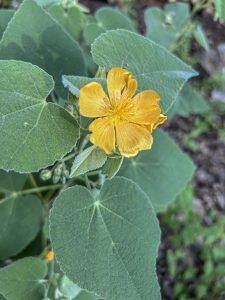
Velvet-leaf Mallow
If Turk’s cap has a rival, I would say it’s velvet-leaf mallow. Reaching 6 feet in good conditions, this bushy perennial shrub grows best in part shade and blooms prolifically from June through October. Like those of Turk’s cap, its flowers, which range from Its orange to butter yellow, attract various species of skippers. It’s the leaves, however, that garner the most attention from people. Large and heart-shaped, they indeed feel like plush fabric.
Through it thrives in moist soil, velvet-leaf mallow also occurs on dry, rocky ground in open woods. It spreads primarily by seed. The plant in this photo is a volunteer that has been growing beside a shady path in my yard for years.
Rock Rose
Of all our native mallows, rock rose is to me the most generous. This tough perennial will grow in sun or shade, blooms and seeds prolifically from spring through fall, thrives with water but tolerates heat and drought, and spreads like crazy. At my house, it grows not only along the shady paths and in sunny wildflower spaces, but also in the deep woods where I never planted it. Although deer will browse it, particularly the electric pink flowers, rock rose doesn’t seem to mind. I’ve never counted, but I suspect I have at least a hundred plants, almost all of which are volunteers. These are growing along a path in my front yard.
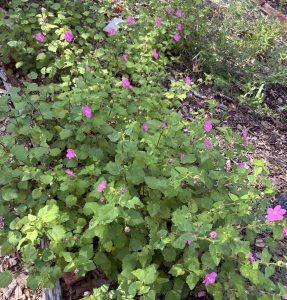

Indian Mallow
Smaller and more delicate-looking than velvet-leaf mallow, Indian mallow is an equally prolific bloomer but prefers sun and drier soil. Its orange to yellow flowers provide food to a variety of pollinators, and the plant is a larval host to several species of skippers. It’s also appealing to birds, small mammals, and deer. Reaching 2-3 feet in height, Indian mallow blooms from June through October and spreads by seed. The plant pictured here is growing in open woods behind my house.
Winecups
Texas is blessed with two varieties of winecups, a perennial groundcover (Callirhoe involucrate) and an erect annual (Callirhoe leiocarpa), which is pictured here. Like other mallows, winecups appreciate water but can tolerate drought. The stunning burgundy-colored blooms appear in both sun and part-shade, making winecups a popular addition to wildflower seed mixes.
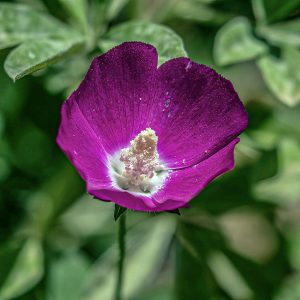

Spreading Fanpetals
Of all the mallows profiled here, spreading fanpetals or spreading sida is both the least conspicuous and the least appreciated. This ground-hugging perennial grows in dry, sandy soil or gravel and produces yellow-orange flowers from April to October. Though small, the flowers and seeds provide food for pollinators and songbirds. Considered a weed by many, spreading fanpetals can often be found flourishing, as this example was, right next to the road.

Susasn Hanson
Editor, The Loop
